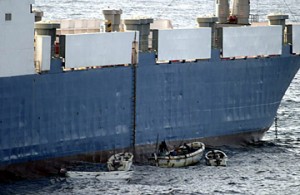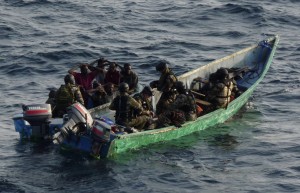By LCDR Claude Berube, USNR; LT Chad Hutchins, USN; and N.R. Jenzen-Jones
The following is a guest post inspired by the questions in our Maritime Futures Project. For more information on the contributors, click here. Note: The opinions and views expressed in these posts are those of the authors alone and are presented in their personal capacity. They do not necessarily represent the views of their parent institution U.S. Department of Defense, the U.S. Navy, any other agency, or any other foreign government.
1. What manner of broad trends are emerging in pirate activities, and how will these develop in the future? Where will we see continued, increased, or emerging piracy over the next 5-10 years?

From a macro perspective, piracy will increase worldwide as western navies continue to contract in size and non-state actors become super-empowered. Piracy will remain and even flourish in regions of diminished state maritime security caused by land-based conditions. Half of the National Intelligence Council’s recent Global Trends 2030 top-ten countries of high-risk destabilized governments have significant coastlines – Niger, Nigeria, Kenya, Somalia, and Yemen. Destabilized nations will offer opportunities to pirate criminal networks as state navies – particularly Western navies – do not have sufficient assets or comparative interests to exert necessary influence. West Africa will pose a continuing challenge if steps are not taken to curb piracy in the region; significant national interests exist there for many nations, including the US, China, and many European nations. Energy security will be a key factor in the decision to support counter-piracy strategies in West Africa.
Since its origins, four things have had to be present for piracy to exist: (1) Non-existent or weak government on land, (2) Ungoverned territorial seas, (3) Access to shipping lanes, and (4) Access to boats, manpower, and arms. It’s important to continually watch any coastal nation which meets these criteria, no matter the size, for developing signs of pirate activity.
2. Which response strategies will best limit or curtail pirate activity over the next 5-10 years?
Specific to Somali piracy, current efforts – including coalition forces, independently operating platforms, industry employment of Best Management Practices, and the increased use of armed guards, have been sufficiently effective as evidenced by the decrease in attacks on commercial ships in the Gulf of Aden. Continued success will however hinge on the sustained availability of coalition forces, which is in turn based on the comparative threats faced by participating states and the impact of their economies and debts to future military operations, acquisitions, and maintenance. Because of the uncertainty of state naval presence, industry will either return to a pre-2008 level of ‘acceptance of risk’ in the region, turn increasingly to armed guards and other private sector capabilities, or rely more on alternative powers such as India and, especially, China. Broader, cooperative international engagement will be necessary. Land-based engagement strategies will also be increasingly important, but will be largely dependent on access, funding, and political will. The U.S. Department of State is beginning to move in this direction now.
3. Which vessels in Western navies should we be looking to for their utility in conducting counter-piracy operations?

Policymakers may ask if the best use of a billion dollar warship is as a platform against modern pirates. While surface warships are a flexible asset, with helicopter detachments providing extended range and tactical small boats for boarding, they come at a price. Depending on future budgets, Western navies could turn to smaller ships with UAVs or inexpensively modified commercial platforms. The U.S. Navy, in concert with European navies, could explore building a piracy squadron of ships such as the Sea Fighter (FSF-1) to work in concert with a dedicated mothership. Modular design of mission-specific ‘packages’ may provide another opportunity to decrease operating costs and use next-generation vessels more effectively.
4. What advice would you give to a smaller nation on the counter-piracy specific maritime investments it should pursue, and why?
Smaller nations in destabilized regions rarely have the economic capacity to support a viable counter-piracy force, leaving them with two options. The first option is to work with larger nations interested in capacity building. Larger nations and their industries have a need for stability on the high seas for global commerce. There are a number of capability development programs offered by nations including the U.S. and China. In Africa, in particular, programs such as African Maritime Law Enforcement Partnership (AMLEP) and Africa Partnership Station (APS) have had some success, but need to be expanded and better integrated into the broader counter-piracy strategy.
The second option is to employ vetted, credible maritime security companies which may provide a less-expensive alternative in the long-term. Maritime security companies have had some success in Africa, providing specific training and personnel where capability gaps exist. Employing private companies allows countries to focus on nascent piracy, or threats such as illegal, unreported, and unregulated (IUU) fishing or oil bunkering, which may be considered less serious by major powers. The use of private security companies is generally compatible with working with larger nations, and opportunities for third-party funding may arise in the future.
